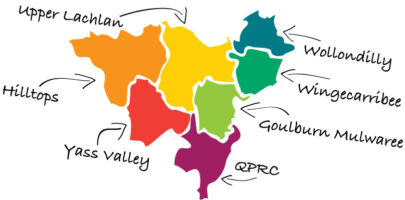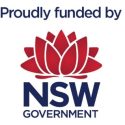Animals by Jan Green and Dianna Bisset
Jan Green and Dianna Bisset both live and make art in Taralga in the Upper Lachlan region. They have created 10 animal designs that are installed along the main street of Taralga. Each of the designs includes a statement to encourage people to slow down within the 50km speed limit for traffic.
Whimsical and fun the works address the serious issue of speeding traffic through the town. Each animal is a great opportunity to stop and grab a pic with the family and explore the unique heritage and art of Taralga.
Chicken, Sheep and Cow
Designed by Jan Green based on the riddle Why did the chicken Cross the Road?
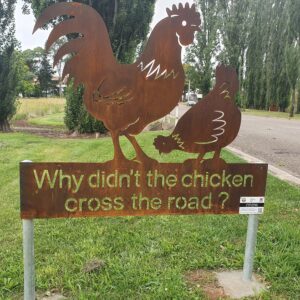
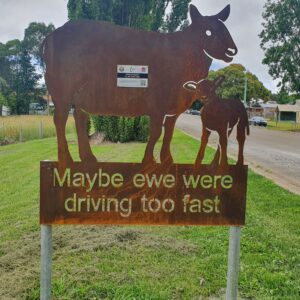
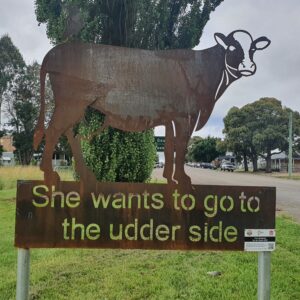
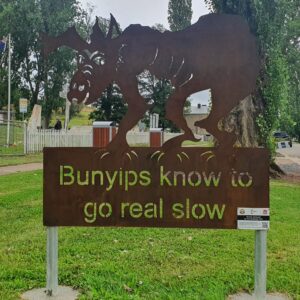
Bunyip designed by Dianna Bisset
Bunyips are creatures that lurk in billabongs, creeks and swamps such as the swamp in the middle of Taralga. There are a variety of stories about bunyip-like creature by First Nations peoples mythology across Australia. I’m sure they exist here in the middle of Taralga. Can you find a bunyip? Listen for their howling roar. Have you seen this shy creature of the night? Leave him a fresh fish or yabbie and you might catch the glint of him just there out of the corner of your eye.
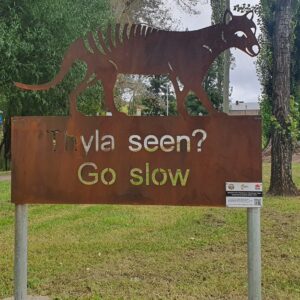
Benjamin the Thylacine or Tasmanian Tiger designed by Dianna Bisset
“I saw him last night just out of reach, his shadow was there in the corner of my eye, a rusty coloured striped blur”
Thylacines became extinct over 3,000 years ago on the mainland of Australia. The Wombeyan Caves was a biodiversity hot spot with evidence of so many species found, including the bones of a Thylacine found in 1896 On 7 September 1936 only two months after the species was granted protected status, ‘Benjamin’, the last known Thylacine, died from exposure at the Beaumaris Zoo in Hobart. It is estimated there were around 5000 Thylacines in Tasmania at the time of European settlement. Devils and Thylacines would have been the dominant carnivores of this region over the last 50,000 years, being replaced by canids (dogs dingoes) at the time of their mainland extinction. Benjamin Thylacine represents all those species that have disappeared from Australia. My heart believes they are not extinct, just very shy and hard to find.
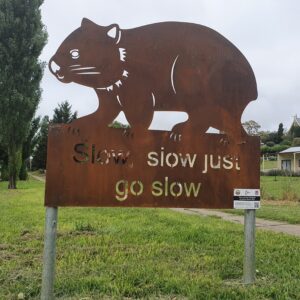
Flora Wombat designed by Dianna Bisset
Wombats are often seen roadside, sadly generally it’s been hit by a car and its legs are in the air. So we want traffic to go slow, just go slower from Dusk till Dawn. Wombats have one Joey at around 3 years of age who takes 2 years to fully mature enough to leave mum, they live in Burrows they dig themselves. Wombats live 12-15 years in the wild. Wombats are dear to our hearts as Dianna and Warwick run a wildlife refuge and rescue, care for and soft release a range of wildlife, Wombats, Wallaby’s Kangaroos. This is well away from roads from their property at Wombeyan Caves. Wombats have a pouch between their back legs where the joey lives for 9 months, and if mum is killed by a car the joey is often still alive. If its safe to do so pull the wombat off the road check the pouch and call the closest wildlife carer. Google the location and wildlife carer to find your nearest. Never feed joey keep it just warm. ‘
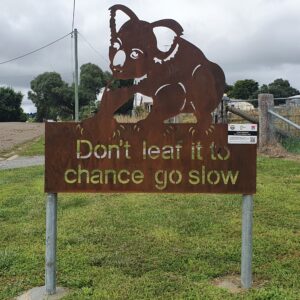
Koala designed by Dianna Bisset
The Koala is an Australian icon and is present in a number of locations around Taralga. They can be found in larger tracts of remnant trees within farmland, as well as in local national parks and along rivers such as the Tarlo and Abercrombie. Koalas of the Blue Mountains are among those with the highest level of genetic diversity in Australia. With populations decimated by the fur trade in the early 1900s, the resulting in-breading has taking a toll. The recent 2019 bushfires have again dramatically reduced numbers and we know the local population in the Wombeyan Caves area has all but gone. Koalas are slow on the road so watch out and go slow. Koalas and wombats are closely related and are both threatened due to loss of habitat.
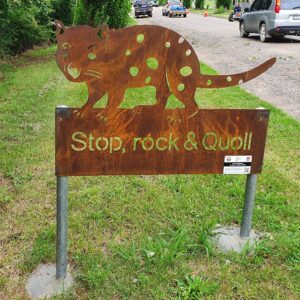
Quoll designed by Dianna Bisset
Mirrangan the spotted tail Quoll seen and heard until around 2017 in the Rocklily area and still exist locally to Taralga area.
The Gundungurra Aboriginal tribe inhabited the area, which covered most of the blue mountains. We respect that these first Australians lived in harmony with the land for many tens of thousands of years. There is little local Aboriginal history or stories in our local area that we know of but there is an important creation dreaming story about Jenolan and Wombeyan caves as well as the rivers associated with them.
Gundungurra people’s knowledge of the caves goes back a long way, and there is a dreamtime creation story about how this whole countryside came into being. The story describes an almighty struggle between two ancestral creator spirits, one a giant eel-like creature, Gurangatch, an incarnation of the ancestral rainbow serpent, and the other, a large native cat or quoll, Mirrangan.
The scuffle resulted in the gouging out of the land to form the river systems of the Cox and Wollondilly Rivers, much of which is now under Sydney’s water storage lake behind Warragamba Dam. In this dreamtime creation story, Gurangatch and Mirrangan visited Jenolan as well as Wombeyan (Whambeyan) Caves, which were already part of the landscape.
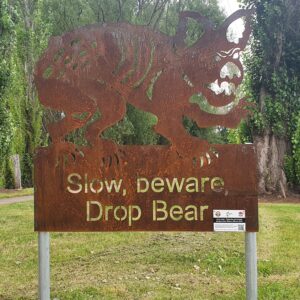
Drop bear: Thylactos plummets designed by Dianna Bisset
Are unusually large predatory carnivorous marsupials related to the koala and wombat also has a pouch for her young. A large tree climber, with strong long claws . Tends to drop silently on it’s prey from great heights. Can also run at great speed like its cousin the wombat. Drop bears eats whatever it can find. Stay safe, in the bush always look up when in the bush at night to see the shining eyes. Dianna and her Husband come across the occasional Drop Bear, but these require special handling and are not for the faint hearted or those lacking imagination.
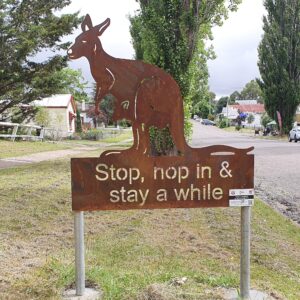
Kangaroo designed by Dianna Bisset
Kangaroos are an icon of Australian wildlife and grace our coat of arms. A favourite of tourists as they are distinctly different to other animals. In the interaction between kangaroos and cars, the cars win. The eastern grey kangaroo, local to the area, eats grass and rests during the day to browse at night. They’re the worlds largest marsupial and can reach 90kg and 2 metres tall. Female kangaroos can have a joey in the pouch feeding from one teat and another ‘at foot’ feeding a different milk from the second teat. They only breed when conditions are good and can hold a foetus back indefinitely in bad seasons. Living in mobs, they shy away from humans. It takes 4 kangaroos to eat as much as one sheep. The bushfires of 2019 decimated the wildlife including kangaroos in the national parks locally and across Australia. We love our mob of wild kangaroos they are bits from many mobs and are what made it thru the bushfires and floods now calling the gasses of Rocklily home.
STA MEMBERSHIP
free & connects you to the STA universe
Reach out to us
[email protected]
0427 938 110
Or by appointment at one of our
Mobile Office locations
PO Box 1323 Goulburn 2580
ABN 67 208 214 681
We acknowledge Aboriginal people as the traditional custodians of the lands where we create, live & work.
© Southern Tablelands Arts. All Rights Reserved


